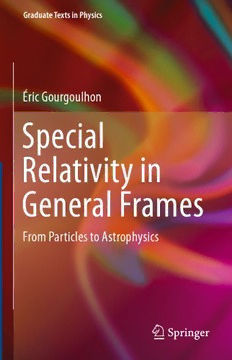
Special Relativity in General Frames: From Particles to Astrophysics PDF
Preview Special Relativity in General Frames: From Particles to Astrophysics
Graduate Texts in Physics Éric Gourgoulhon Special Relativity in General Frames From Particles to Astrophysics Graduate Texts in Physics Forfurthervolumes: www.springer.com/series/8431 Graduate Texts in Physics Graduate Texts in Physics publishes core learning/teaching material for graduate- and advanced-level undergraduate courses on topics of current and emerging fields within physics,bothpureandapplied.ThesetextbooksservestudentsattheMS-orPhD-leveland theirinstructorsascomprehensivesourcesofprinciples,definitions,derivations,experiments and applications (as relevant) for their mastery and teaching, respectively. International in scope and relevance, the textbooks correspond to course syllabi sufficiently to serve as required reading. Their didactic style, comprehensiveness and coverage of fundamental material also make them suitable as introductions or references for scientists entering, or requiringtimelyknowledgeof,aresearchfield. SeriesEditors ProfessorWilliamT.Rhodes DepartmentofComputerandElectricalEngineeringandComputerScience ImagingScienceandTechnologyCenter FloridaAtlanticUniversity 777GladesRoadSE,Room456 BocaRaton,FL33431 USA [email protected] ProfessorH.EugeneStanley CenterforPolymerStudiesDepartmentofPhysics BostonUniversity 590CommonwealthAvenue,Room204B Boston,MA02215 USA [email protected] ProfessorRichardNeeds CavendishLaboratory JJThomsonAvenue CambridgeCB30HE UK [email protected] ´ Eric Gourgoulhon Special Relativity in General Frames From Particles to Astrophysics 123 E´ricGourgoulhon LaboratoireUniversetThe´ories ObservatoiredeParis,CNRS,Universite´ParisDiderot Meudon,France TranslationfromtheFrenchlanguageeditionof:Relativite´restreinte:Desparticulesa` l’astrophysique,(cid:2)c 2010EDPSciences,CNRSEdition,France. ISSN1868-4513 ISSN1868-4521(electronic) GraduateTextsinPhysics ISBN978-3-642-37275-9 ISBN978-3-642-37276-6(eBook) DOI10.1007/978-3-642-37276-6 SpringerHeidelbergNewYorkDordrechtLondon LibraryofCongressControlNumber:2013942463 (cid:2)c Springer-VerlagBerlinHeidelberg2013 Thisworkissubjecttocopyright.AllrightsarereservedbythePublisher,whetherthewholeorpartof thematerialisconcerned,specificallytherightsoftranslation,reprinting,reuseofillustrations,recitation, broadcasting,reproductiononmicrofilmsorinanyotherphysicalway,andtransmissionorinformation storageandretrieval,electronicadaptation,computersoftware,orbysimilarordissimilarmethodology nowknownorhereafterdeveloped.Exemptedfromthislegalreservationarebriefexcerptsinconnection with reviews or scholarly analysis or material supplied specifically for the purpose of being entered and executed on a computer system, for exclusive use by the purchaser of the work. Duplication of this publication or parts thereof is permitted only under the provisions of the Copyright Law of the Publisher’slocation,initscurrentversion,andpermissionforusemustalwaysbeobtainedfromSpringer. PermissionsforusemaybeobtainedthroughRightsLinkattheCopyrightClearanceCenter.Violations areliabletoprosecutionundertherespectiveCopyrightLaw. Theuseofgeneraldescriptivenames,registerednames,trademarks,servicemarks,etc.inthispublication doesnotimply,evenintheabsenceofaspecificstatement,thatsuchnamesareexemptfromtherelevant protectivelawsandregulationsandthereforefreeforgeneraluse. While the advice and information in this book are believed to be true and accurate at the date of publication,neithertheauthorsnortheeditorsnorthepublishercanacceptanylegalresponsibilityfor anyerrorsoromissionsthatmaybemade.Thepublishermakesnowarranty,expressorimplied,with respecttothematerialcontainedherein. Printedonacid-freepaper SpringerispartofSpringerScience+BusinessMedia(www.springer.com) To Vale´rieandMaxime Foreword The theory of special relativity holds a distinctive place within physics. Rather thanbeingaspecificphysicaltheory,itis(similartothermodynamicsoranalytical mechanics)ageneraltheoreticalframework withinwhichvariousdynamicaltheo- ries can be formulated.In this respect, a modern presentation of special relativity must put forward its essential structures before illustrating them by concrete applicationstospecificdynamicalproblems.Suchisthechallenge(sosuccessfully met!)ofthebeautifulbookbyE´ricGourgoulhon. Contrary to most textbooks on special relativity, which mix the presentation of this theory with that of its historical development and which sometimes write the specific form of “Lorentz transformations” before indicating that they leave a certainquadraticforminvariant,thebookbyE´ricGourgoulhoniscentred,fromthe very beginning, on the essential structure of the theory, i.e. the chrono-geometric structure of the four-dimensional Poincare´–Minkowski spacetime. The aim is to train the reader to formulate any relativity question in terms of four-dimensional geometry. The word geometry has here the meaning of “synthetic geometry” (a` la Euclid) in contrastwith “analytic geometry”(a` la Descartes). Under the expert guidanceofE´ricGourgoulhon,thereaderwilllearntoset,andtosolve,anyproblem ofrelativitybydrawingspacetimediagrams,madeofcurves,straightlines,planes, hyperplanes,conesand vectors. He will get accustomedto visualizing the motion ofaparticleasalineinspacetime,tothinkaboutthetwinparadoxasanapplication ofthe“spacetimetriangleinequality”,toexpressthelocalframeofanobserveras a four-dimensionalgeneralization of the Serret–Frenet triad, to compute a spatial distanceasageometricmeanoftimeintervals(viathehyperbolicgeneralizationof thepowerofapointwithrespecttoacircle)ortounderstandtheSagnaceffectby consideringtwohelicesinspacetimewoundinoppositedirections. Besides the pedagogicalcharacteristic of being centred on a geometric formu- lation, the book by E´ric Gourgoulhon is remarkable in many other ways. First of all, it is fully up to date and very complete in its coverage of the notions and resultswherespecialrelativityplaysanimportantrole:fromThomasprecessionto thefoundationsofgeneralrelativity,includingtensorcalculus,exteriordifferential calculus,classicalelectrodynamics,thegeneralnotionofenergy–momentumtensor vii viii Foreword and a noteworthy chapter on relativistic hydrodynamics. In addition, this book is sprinkled with enlightening historical notes, in which the author summarizes in a condensed, albeit very informative way the (sometimes very recent) results by historians of science. Finally, the book is richly laden with many examples of applications of special relativity to concrete physical problems. The reader will learn the role of special relativity in various domains of modern astrophysics (supernovanebulae,relativisticjets,micro-quasars)inthedescriptionofthequark- gluonplasmaproducedinheavyioncollisions,aswellasinmanyhigh-technology experiments:from laser gyrometersto the LHC, including modernreplicationsof theMichelson–Morleyexperiment,matterwaveinterferometers,synchrotronsand theirradiation,andthecomparisonofatomicclocksembarkedonplanes,satellites ortheInternationalSpaceStation. IamsurethattheremarkablyrichbookbyE´ricGourgoulhonwillattractthekeen interestofmanyreadersandwillenablethemtounderstandandmasteroneofthe fundamentalpillars(withgeneralrelativityandquantumtheory)ofmodernphysics. Bures-sur-Yvette,France ThibaultDamour Preface Thisbookpresentsageometricalintroductiontospecialrelativity.Bygeometrical, it is meant that the adopted point of view is four dimensional from the very beginning. The mathematical framework is indeed, from the first chapter, that of Minkowskispacetime,andthebasicobjectsarethevectorsinthisspace(oftencalled 4-vectors). Physical laws are translated in terms of geometricaloperations(scalar product,orthogonalprojection,etc.)onobjectsofMinkowskispacetime(4-vectors, worldlines,etc.). Many relativity textbooks start rather by a three-dimensional approach, using space+timedecompositionsbasedoninertialobservers.Onlyinthesecondstage theyintroduce4-vectorsandMinkowskispacetime.Inthisrespect,theyarefaithful to the historical developmentof relativity. A more axiomatic approach is adopted here, setting from the very beginning the full mathematical framework as one of thepostulatesofthetheory.Fromthispointofview,thechosenapproachissimilar to that adopted in classical mechanics or quantum mechanics, where usually the exposition does not follow the history of the theory. The history of relativity is undoubtedlyrich and fascinating, but the objective of this book is the learning of special relativity within a consistent and operationalsetting, from the bases up to advancedtopics.Thetextis,however,enrichedwithhistoricalnotes,whichinclude referencestotheoriginalworksandtothestudiesbyhistoriansofscience. Usually, the geometric approach is reserved for general relativity, i.e. for the incorporation of the gravitational field in relativity theory.1 We employ it here for special relativity, taking into accounta geometric structure much simpler than that of generalrelativity: while the latter is based on the conceptof differentiable manifold,specialrelativityreliesentirelyontheconceptofaffinespace,whichcan be identified with the space R4. Consequently, the mathematical prerequisites are relatively limited; they are mostly linear algebra at the level of the first two years ofuniversity.Themathematicsusedhereisactuallythesame asthoseofa course 1TwonotableexceptionsarethemonographsbyCostadeBeauregard(1949)andSynge(1956). ix
